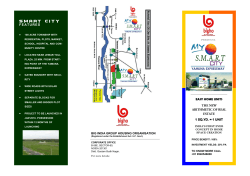
Introduction to Computer Systems
Introduction to Computer Systems CS-101 Lecture 2 By : Lecturer : Asad Abd Elrashid Department of Computer Science College of Arts and Science 1 Content Classification of Computers. Computers based on Technology. Computers for Organization. Classification of Memory. Computer Applications. Advantages and disadvantages. 2 Classification of computers Computers based on Technology 1. Digital Computer : Using only 0’s and 1’s. Both can store in small size of memory called bit. 8 bits equal to 1 byte. 2. Analog computer : Process values which keep changing with time. Data may be in voltages, frequencies, temperature, …etc. E.g. Speedometer 3. Hybrid Computer : It works as digital and analog computers so, it is called analog-digital computer. Accepts analog signals and converts into digital Computers for Organization 1. Micro Computer : It is powerful, easy maintenance and low cost. It is the most common type of PC and commonly called as desktop. Size is small Less storage The length of lines in the range 8-32 bits E.g.: IBM PC, PS/2 2. Mini Computer : Capabilities between main frame and micro computers. Called mid-range computers. Word length is 32 bits. It is used by small and mid-size business organizations. Cont.. 3. Main frame Computer : More powerful than micro computers Word length size is 48,60 or 64 bits High processing speeds Can store large amounts of data Used in research organizations, large industries, large business and government organizations They need more electricity E.g.: IBM 3000 series, UNIVAC 1180 Cont.. 4. Super Computers : Used for scientific and engineering applications. Word length is 64-96 bit. They can have very large data bases(uses more data). They can do one trillion operations per second. Used in the field of science, defense, designing and launching missiles, weather forecasting and biomedical research. Highest speed E.g: CRAY-3, HITAC S-300 Classification of Memory 1. Primary memory Directly used by the CPU . Very fast. Volatile memory: The memory that loses its contents when the computer is turned off.(RAM) Since the CPU can read or write the data to the memory they called as read-write memories. Eg. RAM (Random Access Memory): It is temporary memory. Non volatile memory: store data permanently. E.g. ROM (Read Only Memory): The information stored in it can be only read. 2. Secondary Memory It is the permanent memory which stores large amount of information for a long time It’s also called back up memory or auxiliary memory. E.g. Floppy disc, hard disc, CD drive, DVD drive, DivX drive Uses Magnetic property, magneto –optical property, optical property, solid state memory 3. Cache memory It’s a high speed memory between CPU and main memory. Higher speed It stores data and instructions that are currently to be executed Computer Applications 1. Science:Computer is used by scientists to analyze large quantity of data in some area like(monitoring the earthquake, Nuclear research, ..etc) Used satellite launching and remote controlling. 2. Education:Computers are used for teaching(E-Learning). Computer Applications 3. Medicine and Health:Diagnosing the illness using the computer images and results; they know cause of the disease (scan, x-ray) 4. Engineering/Architecture/Manufacturing:Computer used for planning, designing and drawing the layouts for house, roads, dams etc. 5. Communication:Send and receive e-mails, e-shopping, e-banking, ecommerce and e-learning etc. Computer Applications 6. Business and banking : For administrative purposes, preparing salary bills. Used in banking, insurance sectors and marketing. Used in online payments, transactions, publishing and online business. Computer Applications 7. Governments: Used for weather forecasting, in military, satellite launching and controlling, communication, egovernment …etc. For police force to search all information on criminals, crime scenes, driving licenses etc. 8. Entertainment : Used in music industry, games, …etc. Computer animation and colorful graphics with multimedia effect. Advantages/Merits of computers 1. Speed:- very high speed and Speed is measured in MIPS and BIPS. 2. Accuracy:-The results are very correct. 3. Reliability:-It gives correct and consistent result always 4. Storage capability:- store large amounts of data 5. Versatility:- can do different types of jobs 6. Diligence:- it won’t get tired Disadvantages/De-Merits of computers 1. Non-Intelligent: It just do the given operations. It does not think. It does not possess any intelligent for analyzing the problem. 2. Inactive:• If No power supply, it won’t work. Editors To enter program and edit it Assembler Converting assembly language instructions to machine instruction by a assembler Debugging is Debugging is easy easy E.g.: Turbo C E.g,: TASM Compiler Interpreter High level Line by line language compilation translates into machine language Debugging is Debugging is faster slow E.g. TC Eg: BASIC computer Thank you for your attention 19 Lecturer : Aasd Abd Elrashid
© Copyright 2025





















